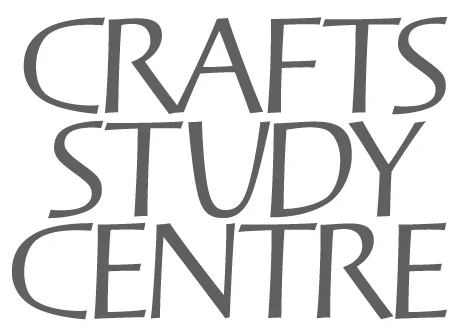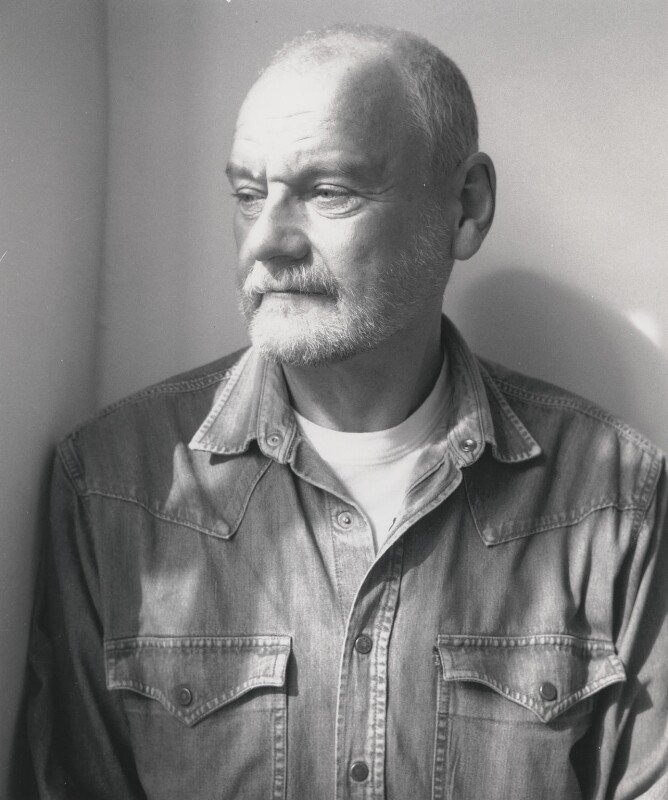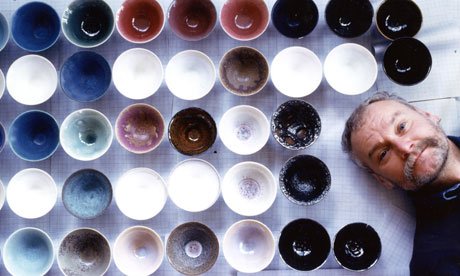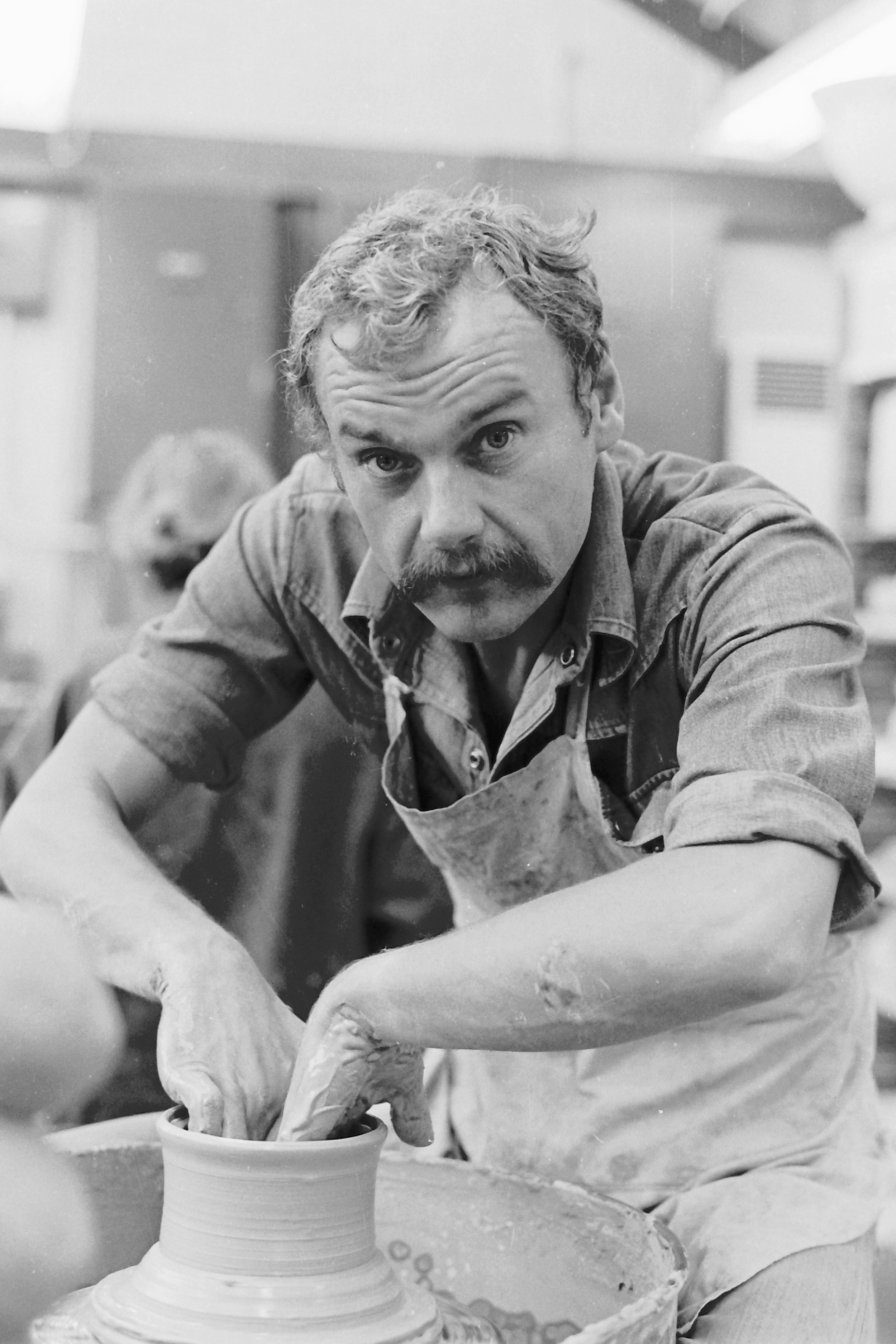The Emmanuel Cooper Memorial Lecture Series was initiated in 2014 through a partnership between the Crafts Study Centre and 318 Ceramics to celebrate the life and work of renowned potter and author Emmanuel Cooper.
Speakers include key individuals at the heart of ceramic research and practice.
PREVIOUS LECTURES
24 March 2025
JULIAN STAIR: MATERIAL, AGENCY AND EMBODIMENT: POTTERY IN THE 21ST CENTURY
In this lecture Stair argued that the multi-modality of ceramics, and pottery in particular, operates as a significant artistic genre within the theoretical framework and praxis of contemporary art. In actively shaping experience through rituals that both embody and conceptualise narratives from the quotidian to the profound, from ‘breaking bread’ to mediating death, Stair situates pottery as providing an opportunity for philosophical re-evaluation of how institutions validate, and markets consume, art. In our increasingly atomised existence (through the advent of the metaverse), the materiality, agency and social locus of pottery remind us what it means to be human.
Julian Stair is one of the UK’s leading ceramic artists, exhibiting internationally since 1982 and with work in over 30 public collections including the V&A, British Museum, American Museum of Art & Design, Mashiko Museum of Ceramic Art, Japan, Museum Boijmans van Beuningen, Rotterdam, Kolumba Museum, Cologne, and the Crafts Study Centre.
This lecture was held at the Royal College of Art, Kensington. Lecture Theatre 1. For more information.
11 March 2024
PAUL GREENHALGH: THE WEIGHT OF BEING: THOUGHTS FROM THE CERAMIC PAST
How did ceramic artists of the past think about their practice? How did they position their practice in their respective cultures? How does this impact contemporary ceramic? This lecture will explore the underlying nature of ceramic history, arguing that it is a ‘thing in itself,’ rather than a branch of art history dependent on other disciplines. Using several case studies from antiquity onwards, finishing in the contemporary, the lecture will look at the theoretical and empirical characteristics of the ceramic past, to identify what makes it relevant today.
Paul Greenhalgh is a historian, writer and curator. He trained as a painter before becoming an art historian, and first encountered ceramic in his first teaching job at Cardiff College of Art. He recently retired from his role as Director of the Zaha Hadid Foundation. His previous roles include Director of the Sainsbury Centre (UK), Director and President of the Corcoran Gallery of Art (Washington DC), President of NSCAD University (Canada), and Head of Research at the V&A Museum. He has curated exhibitions and taught in art schools and universities in a number of countries. His books include Modernism in Design (1990), Art Nouveau 1890-1914 (2000), The Modern Ideal (2004), The Persistence of Craft (2009), Fair World (2010), Pablo Picasso: the Legacy of Youth (2020); and Ceramic Art and Civilisation (2021).
This lecture was held at the Royal College of Art, Kensington. Lecture Theatre 1. For more information.
21 February 2020
CELEBRATING THE LIFE AND WORK OF EMMANUEL COOPER, David Horbury
Interest in the pots of Emmanuel Cooper has increased enormously in the years since his death in 2012. However, Cooper was always more than a potter and in a career of almost half a century he developed a substantial reputation as a writer, teacher, editor, curator, advocate and activist. For many commentators it was this ability to combine a variety of roles and interests which made Cooper such a significant figure within the crafts community – but others have always viewed this diversity with ambivalence, believing it revealed a lack of focus and commitment to his work as a potter.
Through examining key aspects of Cooper’s life and experience, David Horbury will discuss the impact of these conflicting attitudes – on Cooper’s own practise and development – on the response to his pots - and on what they reveal about our ideas concerning the role of the potter.
Held at the Royal College of Arts.
26 February 2019
CLAY ‘MATTERS’, Felicity Aylieff
Many thought that with the global digital explosion of the 1990s and virtual technology, the use of clay and making ceramics would be reduced, but there is a renewed interest in matter, craftsmanship, the acquisition of creative skills, and an opening to the sensory world, offered through working with clay.
Clay is the mother of materials – the universal material of the earth. It’s primordial, it’s transformational, it’s tactile, it’s malleable. It’s the material that people respond to. It is charged with philosophical significance dating back to ancient times, and most importantly it is inherently democratic, from the common house brick to rocket science. The lecture looked at the growing number of contemporary artists working in the expanded field of clay, and also the significance of clay as a form of expression to Aylieff as an artist.
Held at the University for the Creative Arts.
6 March 2018
MEISSEN FOUNTAIN RESTORATION, Steve Brown
This illuminating lecture takes its audience on the captivating journey of this enormous task of the Meissen Foundation Restoration.
On the 11th of January 1747 a magnificent dinner party was held to celebrate the marriage of the Dauphin and Princess Maria Josepha of Saxony. Hosted by first minister of Saxony Count Heinrich von Brühl, he commissioned a fabulous surprise to mark the occasion - a centrepiece for the dessert course: a fountain that stretched four metres along the table directly in front of the diners. The fountain was modelled by Johann Joachim Kändler and manufactured by Meissen in their newly invented European hard paste porcelain and was a huge accomplishment.
In 1870, the V&A in London acquired a large group of porcelain objects in ‘a much shattered’ state, and the museum put on display a number of figurative pieces, which were remains of this once monumental table fountain. Reino Liefkes, Senior Curator of Ceramics & Glass at the museum, determined to do something to re-invoke the spectacle that had been seemingly lost to the past, asked Steve Brown and Martin Smith to take on the fountain’s restoration.
28 March 2017
ALTERED STATES: APPROPRIATION OF AN ICONIC CERAMIC FORM, Dr Bonnie Kemske
Dr Bonnie Kemske discusses the cultural appropriation of the teabowl. The teabowl arose to be used within the specific context of a sixteenth-century Japanese artistic and spiritual practice known outside Japan as tea ceremony. Yet today, every UK ceramics fair and many galleries and exhibitions feature teabowls made not for use, but for display on plinth or mantelpiece. The growing ubiquity and iconicity of this form within contemporary ceramics signifies the success of a methodology of appropriation, and raises questions about the relevance of both context and content.
Held at the University for the Creative Arts.
10 February 2016
‘CRAFT’ - A WORD TO START AN ARGUMENT, Sir Christopher Frayling
The word ‘craft’ has many meanings and many associations, and as a result sometimes becomes, in the words of David Pye, “a thought-preventer”. Pye preferred ‘workmanship’; others prefer ‘applied art’; others prefer ‘making’. This lecture explored some of these meanings and associations of ‘craft’ - yesterday and today - and argues that now is a particularly exciting time to put aside differences and energetically to promote the value of making things. The worlds of craft have been examining their navels for far too long.
Held at the University for the Creative Arts.
5 March 2015
USE AND BEAUTY: THINGS, THINKING AND WORK, Alison Britton
Alison Britton OBE discussed Bernard Leach’s famous pairing of ‘use and beauty’. Exploring a thread through her own work that weaves different connections to use and beauty, looking at the way her thinking has evolved througth the mix of making pots, writing and curating.
Held at the University for the Creative Arts.
12 December 2013
IN THE POTTER’S STUDIO, Professor Simon Olding
Simon Olding discussed how key makers treat the contested space of making and potters as collectors.
Held at 318 Ceramics workshops in the newly restored historic Farnham Pottery.







